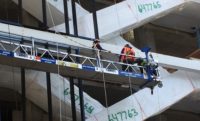Commentary on The American Construction Worker
Boom Times Didn't Win Construction Workers Big Paydays or Retirement Benefits
Labor Day 2018 is a celebration of work, not compensation

A worker signs the final beam during renovation of the Los Angeles Memorial Coliseum in Los Angeles, Aug. 15.
Photo: Image of Sport/Newscom
The much-in-demand American construction craftworker, when it comes down to money and retirement benefits, isn't doing as well as some people may assume.
Labor Day, frankly, isn't labor's celebration of vastly improved paydays and retirement packages. At least not in 2018.
What we know from the last year or so is that while craftworkers remain in short supply in most of the U.S., wage hikes are steady but not skyrocketing. Professional construction staff also appear to be getting steady, unspectacular wage hikes of 3% to 4%, but they are enjoying better bonuses that are 7% to 10% higher than the previous year's bonus.
Construction base pay and salaries are fixed costs that many employers work hard to hold down.
The median wage for what the federal government classifies as a construction laborer is $34,530 a year. And face it: 3% to 7% of $34,500 a year is a much smaller amount than the same percentage of $100,000 per year for those lucky enough to earn that much.
Construction base pay and salaries are fixed costs that many employers work hard to hold down.
Financing retirement is also a problem as the nation's employers have shifted the risk to employees. Last we checked, three of the 13 "Surprising Companies" that Fortune magazine says still provide defined benefit pensions were Swinerton, TDI Industries and Burns & McDonnell.
Altogether, corporate America has been very thorough in dismantling retirement security. In its place are the uncertainties of 401(k) retirement plans.
The Center for Construction Research and Training reports that construction workers are less likely than other workers to be eligible for retirement benefits. From 2000 to 2010, the percentage of wage-and-salary construction employees eligible for retirement benefits of any kind dropped from 46% to 38%, the center reported. That number is surely heading further downward.
This transition from defined benefit to defined contribution retirement plans have no doubt made U.S. employers more competitive and saved countless billions. But they have created a new level of risk for construction workers whose employment is cyclical, seasonal and full of the hazards of injury and bodily wear and tear. Not to mention travel and relocation.
When was the last time you heard of a construction craftworker telecommuting?




